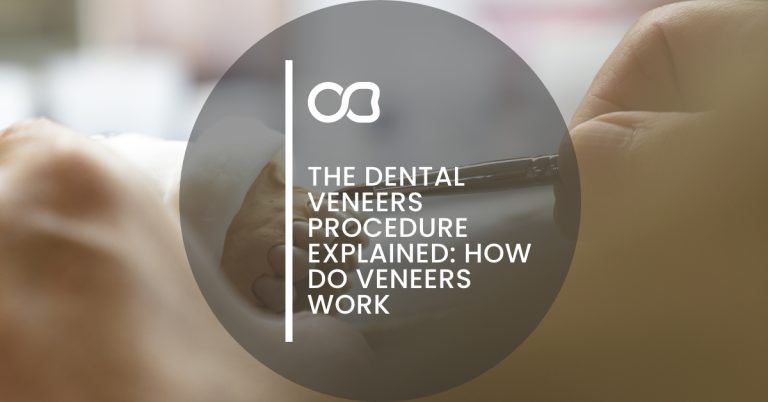The dental veneers procedure is a multi-step process that involves modifying the surface of the teeth and attaching thin, custom-made shells to change their appearance.
While it might seem like quite a simple treatment, there’s quite a bit involved in getting it right – from the preparation process to a careful placement.
In this blog, we’ll go over how the dental veneers procedure actually works, what each stage involves, and what to expect once your veneers are in place.
What are dental veneers made of?
Veneers are thin shells that are bonded to the front surface of teeth. There are two main types, porcelain veneers and composite veneers.
Porcelain is often chosen for its strength and resistance to staining, and it tends to last longer than composite material. The process for porcelain veneers can also be somewhat more extensive, so it typically requires more than one appointment.
Composite veneers can sometimes be applied in just one sitting, depending on the amount of work that will be required.
Composite veneers can be suitable for a quick treatment, but durable porcelain veneers are generally designed to achieve a longer-lasting result.
Your initial consultation and planning process
The dental veneers procedure always starts with a consultation. Your consultation helps to assess whether veneers are suitable, to discuss any issues with the underlying teeth, and to plan the specifics of the treatment.
This might include checking for decay, assessing gum health, and possibly taking X-rays. If there are other dental concerns that need to be addressed first, such as cavities or gum inflammation, these would need to be managed before applying the veneers. At this stage, impressions or scans may be taken, particularly if porcelain veneers are being planned.
You’ll also discuss your specific goals for the treatment results, and how the treatment can be tailored accordingly.
The process of preparing the teeth before placing the veneers
Once the planning is complete, the next step is preparing the teeth. This involves removing a small amount of enamel from the front surface of the teeth to create enough space for the veneers to sit comfortably.
The amount of enamel removed depends on the condition of the tooth and the type of veneer being used. Once the enamel has been removed, an impression of the prepared teeth is taken.
You’ll discuss what to expect for the teeth preparation process during your consultation, including how the enamel removal process will be performed.
Placing, shaping and bonding the veneers
When your veneers are ready to be placed, your dentist will first check the fit, shape and shade of the veneers before moving on to bonding them.
Before bonding, the tooth surface is cleaned and etched to create a slightly rough surface that helps the adhesive grip. The veneers are then carefully secured to the teeth using a specially designed material. A curing light is also used to harden the material and ensure that the veneers stay in place.
The bonding process will need to be completed with high attention to detail, as the veneers need to be positioned precisely. Sometimes, patients are then asked to return after a few weeks for a follow-up appointment.
What to expect after the veneers are applied
Straight after the veneers are fitted, you may notice that your bite feels slightly different, but you should adjust quite soon after the treatment. However, if any part of the veneer feels too high or causes discomfort while chewing, it’s important that you let your dentist know, as some minor reshaping may be needed.
Some sensitivity is also fairly common, especially to hot or cold temperatures, but this should ease over time. If sensitivity lingers for longer than expected, it could mean that the veneer is sitting too close to the nerve or that there’s an issue with the bonding – both of which can usually be corrected with a follow-up appointment.
While veneers are designed to be strong, they still require care. Chewing on hard objects can still damage them, and it will still be important to maintain good oral hygiene in order to keep the veneers and surrounding teeth in good condition.
Who might not be suitable for veneers
Not every patient will be a good candidate for the dental veneers procedure. Teeth that are severely weakened, cracked or have large fillings may not have enough structure left to support a veneer. In these cases, a crown may be a more suitable option.
Gum disease and other untreated oral health issues also need to be resolved before veneers can be considered. Applying veneers to teeth that aren’t healthy underneath can lead to further complications, so the foundation should be healthy first.
You will be able to discuss your suitability for veneers during a consultation and have your dental health assessed carefully before proceeding with the treatment.
Discuss your tailored veneer procedure plan at Oasis Dental Studio in the Gold Coast, Brisbane, Melbourne or Pottsville
The dental veneers procedure will always need to be customised and tailored to suit each patient’s needs.
A consultation at Oasis Dental Studio will allow one of our experienced dentists to consider your aesthetic goals and assess the health of your teeth to create a suitable treatment plan. We will aim to ensure that your teeth are treated in a way that supports their health, function and structure over time.
Please contact our team today to book your consultation in the Gold Coast, Brisbane (West End), Melbourne (Brighton) or Pottsville.

